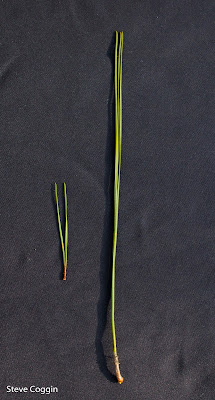 |
| Mature Shortleaf Pine (Pinus echinata). Rowan County, North Carolina |
North
Carolina has been associated with pine trees since colonial days. The extensive stands of pine on the coastal
plain gave rise to the naval stores industry in the age of sail. European colonists produced tar and pitch
from Longleaf Pine that was used to preserve the wood and ropes of sailing
ships. These sticky and aromatic
substances became so closely associated with ships that sailors in the British
navy were called Jack Tars. Naval stores
production caused North Carolinians to be nicknamed Tar Heels. This name is still used for the sports teams
of the University of North Carolina at Chapel Hill. Even the official toast of the state of North
Carolina begins “Here’s to the land of the Longleaf Pine, the summer land where
the sun doth shine.”
North Carolina boasts eleven species of pine (genus Pinus) and they grow from the barrier islands of the coast to the western mountains. Pines all share certain characteristics; scaly bark, cones rather than flowers and leaves in the form of needles. Pines make two types of cones; male and female. Male cones are small and yellow. They release pollen into the air and dust everything from cars to ponds with a fine yellow coating. Some of these pollen grains land on the female cones. Young female cones are prickly nubs that take two years to mature into what we call pine cones. Each scale of a mature female cone bears two winged seeds. At maturity these seeds fly away from the parent tree helicopter style to start a new pine tree.
 |
| Male cones of Loblolly Pine (Pinus taeda). These cones are produced in spring and fill the air with their pollen. Rowan County, North Carolina. |
 |
| Young female cone of Loblolly Pine. Pollination has already occurred and the seeds will develop for two years. Rowan County, North Carolina. |
 |
| Mature female cone of Loblolly Pine. This cone is shedding seeds. Rowan County, North Carolina. |
 |
| The winged seeds of Loblolly Pine. These seeds are released from the female cone and helicopter away to grow into a new tree. Rowan County, North Carolina. |
 |
| A Longleaf Pine (Pinus palustris) savanna in the Sand Hills of North Carolina. This forest expereinces regular fires to keep the understory open. Weymouth Woods State Park. |
 |
| Longleaf Pine sapling. Weymouth Woods State Park, North Carolina. |
Shortleaf Pine (Pinus echinata) does have short leaves. The needles of this tree are 3-4 inches long and come in bundles of two or three. Not only are the needles short, the female cones are only about two inches long, much smaller than those of Longleaf Pines. Shortleaf Pine has a wider distribution than Longleaf Pine, ranging from New York to Florida to Texas.
 |
| Shortleaf and Longleaf Pine Needles. Rowan County, North Carolina. |
 |
| Shortleaf and Longleaf Pine cones. Rowan County, North Carolina. |
Loblolly
Pine (Pinus taeda) is another abundant pine in the Southeast. Its common name
comes from two old English terms for thick porridge or gruel, presumably
referring to the swampy habitat of some Loblollies. Loblolly Pine grows rapidly is an important tree for lumber production in the Southeast.
Eastern White Pine (Pinus strobus) are trees of the mountains and foothills in the Southeast and they are found north to New England, the Great Lakes and Eastern Canada. These are among the tallest conifers. Historical records show Eastern White Pines reaching 175 feet in colonial times. The needles are 3-5 inches long; in bundles of five with white stripes, that gives the tree its name. Female cones of Eastern White Pines are 4-8 inches long and lack spines on their scales.
 |
| The elongate cone of Eastern White Pine (Pinus strobus). Rowan County, North Carolina. |
Southern
Pine Beetle (Dendroctonus frontalis) is a
native insect and a great threat to pines. This beetle is the size of a rice grain and
bores through the bark into the phloem layer.
The female Pine Beetle then begins to excavate galleries and release pheromones that
attract males and other female beetles.
Pine Beetles lay their eggs in the galleries and produce many more
beetles. The pine’s natural defense is
to secret resin to force out the beetle but a mass infestation can overwhelm the
tree and kill it. A major Southern Pine
Beetle outbreak in the early 2000s resulted in economic losses exceeding $1
billion.
 |
| Galleries of Southern Pine Beetle (Dendroctonus frontalis) in a dead Loblolly Pine. Dekalb County, Georgia. |
We use the
resinous sap of pines in many industrial applications, we use their wood for
construction and we pulp their trunks for paper. Beyond this utilitarian view of pines, they
are marvelous trees. Pines live and thrive in harsh environments, are among the first trees to colonize an old farm field and are
keystone species in many ecosystems.
Pine forests harbor many fascinating and even endangered plants and
animals. I, for one, am pleased to live
in the Land of the Pine.

No comments:
Post a Comment